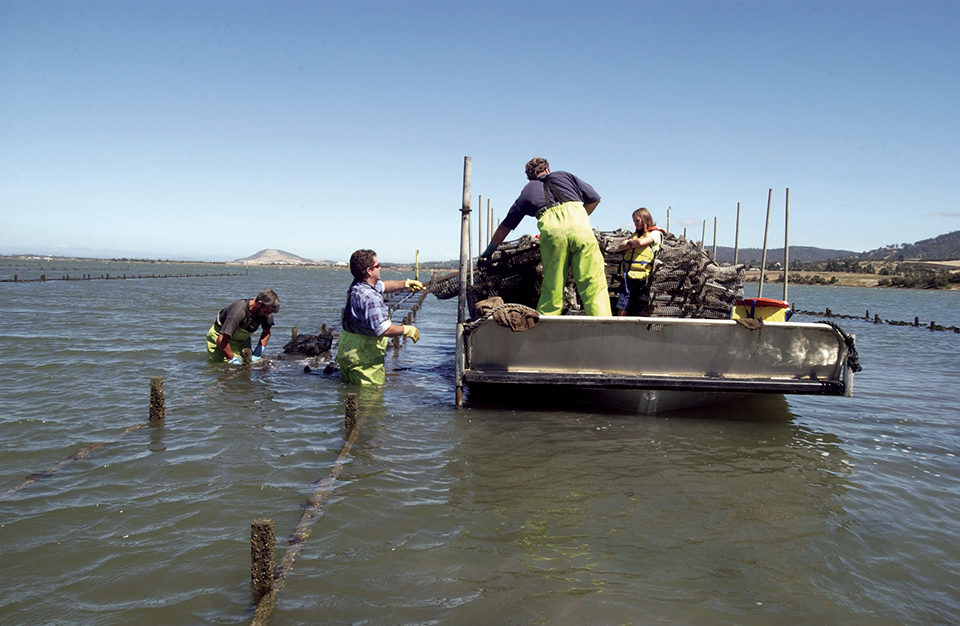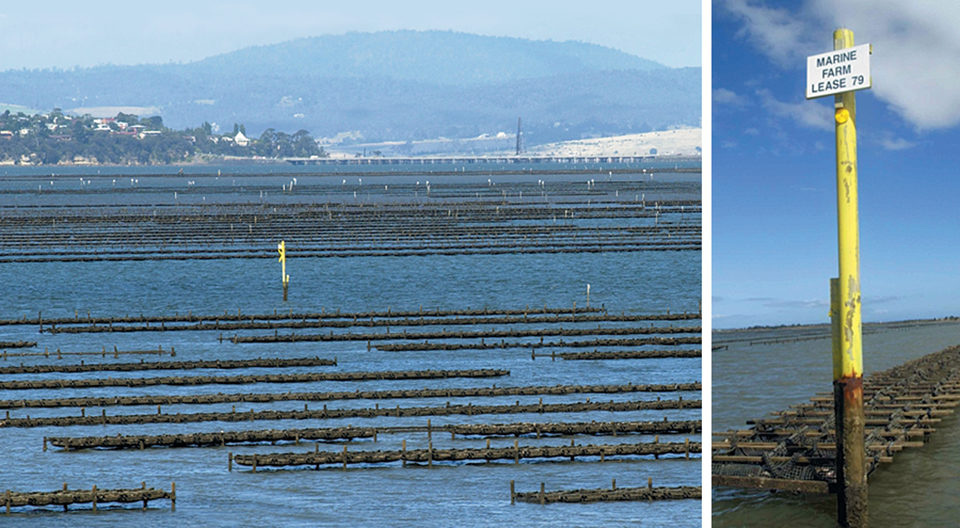Economics, computing combine to deliver gains

Selective-breeding programs are a standard part of animal production and have been an important contributor to improving growth rates and product quality while decreasing the cost of production. Selective-breeding improvements have transformed terrestrial animal production, and although relatively new to Australian Pacific oyster production, are expected to provide a similar transformation of Australia’s oyster industry.
Oyster breeding in Australia
Pacific oyster selective breeding started in Australia in 1997. Although it faced all sorts of challenges, this early work was successful in building a breeding population and establishing the processes and protocols required to run a commercial, industry-based program. However, program limitations hindered the commercial uptake of the selectively bred oysters.
In 2007, Australian Seafood Industries (ASI), the industry-owned company responsible for Pacific oyster selective breeding, teamed up with the Commonwealth Scientific and Industrial Research Organisation (CSIRO) Food Futures Flagship and, with funding assistance from the Australian Seafood Cooperative Research Center, started a “modernization” of the breeding program. This successful partnership brought together ASI’s practical oyster-breeding experience and knowledge of the industry with CSIRO’s skills and experience in genetics and applied selective-breeding programs.
Trait selection for economics
The main limitation to the program was a lack of understanding of which genetic traits to select. While the program was achieving genetic improvements in growth, little was known about other traits that influenced grower profitability and how these should be balanced in selection decisions.
The Australian Pacific oyster industry, which is based solely on half-shell sales, is selling a luxury product, and good appearance and high quality are essential requirements. The production system requires grading and mechanical tumbling to raise that high-quality product. An oyster may receive up to 10 handling events, which significantly influences the cost of production.
When using the selected lines, growers noticed that growth was fast, but product quality, particularly with regard to shell shape, had decreased. And, at times, the fast-growing oysters required an increased amount of handling. The program had slipped into a situation where it was making genetic gains, but probably failing to make economic gains. It also highlighted the complex nature of the Pacific oyster production system, where “best-guess” decisions about the relative trait weightings did not necessarily give good economic outcomes.

Bioeconomic model
The solution was to redefine the breeding objectives and prioritize traits according to their economic values. Although this is commonly done in terrestrial animal-breeding programs, this was the first time it was done in oyster breeding. Assigning economic values to traits required building a bioeconomic model of the Australian half-shell oyster production system.
The model was able to predict how a change in biological traits influenced economic metrics, with cost of production the main measure. The model identified five economically important traits: growth time, shell shape, survival, time required to reach market condition and uniformity. An economic value was calculated for each trait.
For example, improving the survival of oysters from 65.0 percent, the approximate Australian average, to 71.5 percent, a 10.0 percent gain, would decrease the cost of production by 3.5 percent. Similarly, decreasing the throughput time by 10.0 percent by increasing growth rate would decrease the cost of production by 2.5 percent. Increasing the ratio of shell width to length by 10.0 percent, so fewer oysters had unacceptable shell shapes, would decrease costs by 3 percent. Such measures were the basis for weighting traits in selection decisions.
Overcoming slow progress
A second limitation was the slow rate of genetic progress being made, which manifested as growers reporting a “lack of noticeable difference” in the oysters. Data from the breeding program showed the Pacific oyster traits were under rather strong genetic control, so noticeable changes should be expected. The challenge was to accelerate the rate of genetic change.
It is always possible to select more intensively to get more genetic gain, but this must be balanced by the need to manage inbreeding. Genetic gains and inbreeding pull in opposite directions, and finding the right balance is one of the fundamental decisions – and dilemmas – for applied breeders. It is also possible to “do more breeding” to get more gains, but this must be balanced against the logistical and budgetary restraints of the program.
For the oyster program, computer simulations were used to help find that desired balance. Computer simulations are an ideal tool for this because they allow a complex range of “what-if” scenarios to be quickly evaluated on a desktop. The program is now based on producing 50 pedigreed families every year, and although relatively small, there is confidence that a revised population structure and selection strategy can produce better and sustainable gains without the risk of inbreeding.
Better data use
Another aspect to improving the rates of gain was to make better use of the data collected as part of the breeding program. Full use of computing power and modern statistical algorithms can make noticeable differences in applied breeding, a point that is sometimes overlooked in aquaculture breeding.
Revisions of the breeding strategy involved a complete overhaul of the ways in which data analyses were done. Adopting these methodologies also vastly improved the quality of information that flowed to both the breeding program manager and the growers. For example, genetic trends across year classes can be easily and accurately plotted, the precise genetic value of any individual in the breeding population can be estimated and the level of inbreeding between any two animals can be easily determined to assist in selection and mating decisions.
Moving to a data-centered breeding strategy also involved developing data systems and computer software that supports the breeding program. Oyster breeding works to a biological cycle that waits for no one, and there is no point in having economic values of traits, a carefully planned breeding strategy and sophisticated data analyses if breeding decisions cannot be made on time.

Improvements to impact industry
Improvements to the breeding program have allowed the selection of oysters with the best economic mix of traits, better identification of those oysters and more effective management of inbreeding. But the final measure of the changes is the extent to which the growers benefit.
By combining new knowledge of the economic values of traits, the genetic inheritance of these traits and the gains projected in computer simulations, it is estimated that the breeding program will reduce the cost of production by 40 percent over a 10-year period.
(Editor’s Note: This article was originally published in the May/June 2012 print edition of the Global Aquaculture Advocate.)
Authors
-
Peter Kube, Ph.D.
Aquaculture Geneticist
CSIRO Food Futures Flagship
Castray Esplanade
Hobart, Tasmania, Australia -
Matthew Cunningham
General Manager
Australian Seafood Industries Pty. Ltd.
Hobart, Tasmania, Australia
Related Posts

Responsibility
Ailing waterways hail the oyster’s return
The Lower Hudson Estuary and Chesapeake Bay, two waterways once home to thriving oyster beds, would welcome the shellfish’s return. Aquaculture initiatives in both areas aim to reinvigorate the water and the communities they support.

Health & Welfare
Artificial upwelling maintains favorable summer environment for farmed oysters
The summer season poses threats for oyster aquaculture worldwide. In addition to high mortality, poor oyster quality and health – especially in enclosed bays – are often attributed to water stratification, high temperatures and hypoxia.

Responsibility
A look at various intensive shrimp farming systems in Asia
The impact of diseases led some Asian shrimp farming countries to develop biofloc and recirculation aquaculture system (RAS) production technologies. Treating incoming water for culture operations and wastewater treatment are biosecurity measures for disease prevention and control.

Health & Welfare
A study of Zoea-2 Syndrome in hatcheries in India, part 2
Indian shrimp hatcheries have experienced larval mortality in the zoea-2 stage, with molt deterioration and resulting in heavy mortality. Authors considered biotic and abiotic factors. Part 2 describes results of their study.


